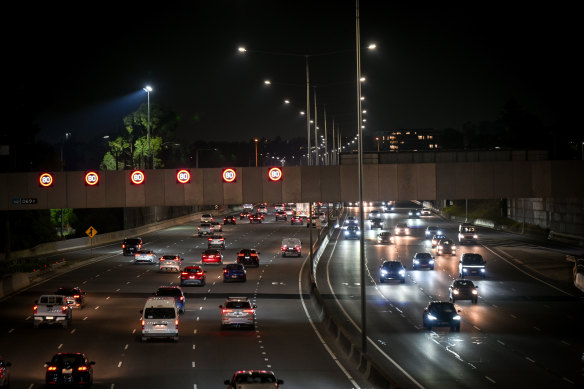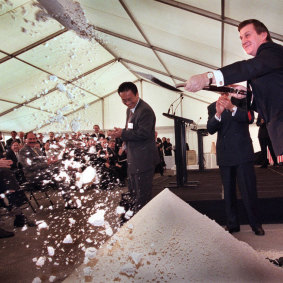Motorists have paid nearly $13 billion to drive on CityLink while toll prices have grown up to three times faster than inflation since the road opened 24 years ago.
Accelerating tolls have helped make CityLink the most profitable of operator Transurban’s 22 roads globally, and reflect what experts say are poor state government deals that push higher prices onto future motorists.

Citylink tolls will increase by 4.25 per cent a year until 2029. Credit: Eddie Jim
The road contributes 27 per cent of Transurban’s total toll revenue, underpinning its growth into a $43 billion ASX-listed company.
Drivers are set for further pain with annual 4.25 per cent price increases locked in until 2029 thanks to Transurban’s deal with the Victorian government to build the $10 billion West Gate Tunnel Project. It will cost more than $22 for a daily pass from July – which is more than three times the price when the road opened in 2000.
David Hensher, a transport economist at the University of Sydney and toll road expert, said fixed toll increases had been a “fundamental error” that delivered generous corporate profits at the expense of motorists.
“It means – especially given the cost-of-living crisis – that many people are paying more to use the toll road than they should,” he said.
Transurban spent $1.8 billion from 1996 to 2000 building the project linking the Tullamarine, West Gate and Monash freeways, which included building the Burnley and Domain tunnels and the Bolte Bridge.
The company says it has spent a further $2.2 billion on upgrades, including widening the Monash in 2010 and the Tullamarine in 2018 to improve travel speeds, while also helping to boost traffic numbers and revenue.
“Customers are continuing to experience travel-time savings of up to 30 minutes on trips using CityLink and have done so over the past 15 years, despite population in Melbourne increasing by around 1.3 million in that time,” a Transurban spokesperson said.
Transurban’s investment in the road had improved connectivity across Melbourne and let the state government direct spending towards “schools, hospitals and other infrastructure needs”, they said.
From July 1, it will cost $22.31 for a daily pass to drive a car on CityLink, which spans from the Monash Freeway in the eastern suburbs to the Tullamarine Freeway in the north-west. That compares with $7.70 when the road fully opened in December 2000 – an increase of 190 per cent, more than twice the rate of inflation over the same period (88 per cent).
Tradies and other workers have been hit even harder: day passes for light commercial vehicles such as utes and vans have quadruped from $12.30 to $48.39 – or three times the consumer price index over the same period.
An analysis by The Age of the past 24 years of Transurban’s financial records shows revenue from CityLink has steadily grown to a cumulative $12.9 billion, in nominal terms and including GST, as of December 2023. Those figures – and the $1.8 billion construction cost – have not been adjusted for inflation and both would be higher in today’s dollars.
Traffic has grown from 194 million trips in 2002 to a high of 311 million in 2019.
CityLink became Australia’s largest infrastructure project since the Snowy River Hydro scheme when the Kennett government awarded Transurban a contract in 1995 to build and operate the toll road for 34 years.
The original CityLink contract allowed Transurban to increase tolls by 4.5 per cent every year – or at the rate of inflation, if greater – until January 2017. But motorists enjoyed only two years of inflation-level price rises.
The Andrews government amended the CityLink concession as part of the deal with Transurban to build the $10 billion West Gate Tunnel, of which Transurban is paying $6.1 billion.
That locked in 4.25 per cent annual price rises from April 2019 to March 2029, and also extended Transurban’s control of CityLink by a decade, from 2035 to 2045.
The Parliamentary Budget Office found in 2019 that those contract changes would deliver $4.7 billion in additional revenue to Transurban by 2045, and an additional $7.5 billion when including traffic from the West Gate Tunnel, using 2019 dollars.
Transurban floated on the ASX in 1996 with a $1 billion market value after securing the CityLink contract. It has since grown into a $43 billion behemoth with 22 roads in Australia and North America, and has rewarded investors with more than $15 billion in distributions.
Despite this growth, CityLink still generates 27 per cent of its global toll revenue.
Independent economist Saul Eslake said the original CityLink deal was “incredibly generous” by locking in above-inflation toll rises in return for Transurban building the road.
“These deals seem to have been ‘heads the proponent wins, tails the motorists lose’,” the former ANZ chief economist said.
“They would be among the few businesses that are able to fully recoup the impact of inflation. It’s no wonder that Transurban has been such a financially successful company.”
Hensher, from the University of Sydney, said state governments had been attracted to private toll roads as a way to get new road infrastructure built without adding debt to their balance sheets, while also getting the perceived efficiency of private sector delivery.
However, fixing toll rises in contracts – rather than setting them based on time savings for motorists and benefits across the wider network – had been a mistake, he said.
“You can’t blame [Transurban] – this is good business. The big issue is to do with how much the taxpayer is forking out and what is the benefit they are getting.”
This year, a NSW government inquiry into Sydney’s toll roads conducted by former Australian Competition and Consumer Commission chair Allan Fels also took aim at contracts with fixed toll-rate increases, saying they reduced governments’ initial contributions to road projects but pushed “more of the funding burden onto future motorists”.
“In the long term, as traffic builds on the roads and tolls continue to escalate, it is likely that concessionaires will benefit significantly,” Fel’s interim report, released in March, said.
Fels has suggested the NSW government take control of Sydney’s toll roads and create a body that would set annual price increases, as well as the introduction of off-peak and dynamic pricing to influence demand.
S&P Global Ratings infrastructure analyst Parvathy Iyer said it was difficult to estimate how profitable CityLink had been for Transurban in isolation from its other assets because of how the company structures debt and costs across the group.
However, Transurban financial reports showed CityLink’s operating profit margin – averaging 85 per cent over the past decade – was the highest out of all the company’s roads and also high compared with similar toll roads globally, she said.
Transurban reported profit margins of 79 per cent on its Sydney roads, 73 per cent in Brisbane and 66 per cent in North America last year.

Then-premier Jeff Kennett shovels sand at the media as he launches construction on CityLink in 1996.Credit: Simon O’Dwyer
“Toll roads that are well managed can operate at anywhere between 65 and 80 per cent margins, so this at the higher end,” Iyer said. “This asset is doing quite well.”
Iyer said CityLink’s high margins reflected the lower cost of managing a single road with multiple sections, rather than the multiple roads Transurban runs in other cities. It is also the critical link connecting Melbourne’s east and north, as well as its port and airport.
“One of the important factors in my opinion is the lack of reliable rail connections across Melbourne – that pushes people onto the roads,” Iyer said.
A spokesperson for Roads Minister Melissa Horne said that tolls were set by contracts and legislation. The government had introduced short-term registration payments and discounts for some motorists to help Victorians “feeling the pinch”.
The state government has established its own tolling company to initially operate the new $26 billion North East Link road, which is due to open in 2028. Transurban has expressed interest in eventually operating the 10-kilometre road.
Get the day’s breaking news, entertainment ideas and a long read to enjoy. Sign up to receive our Evening Edition newsletter here.